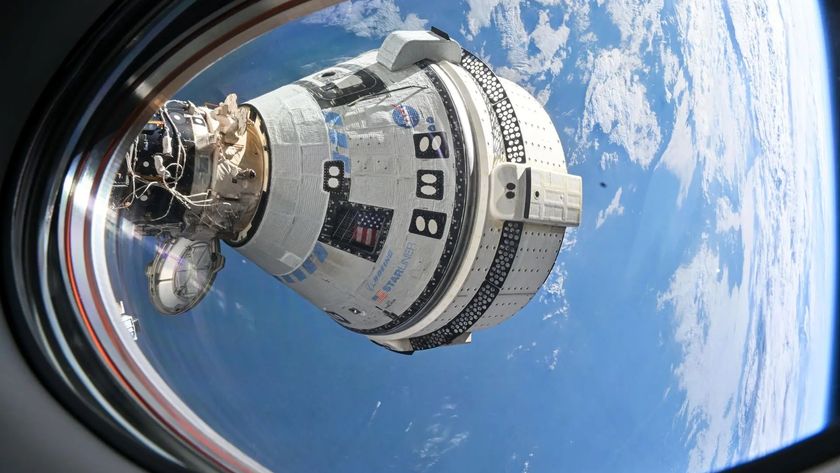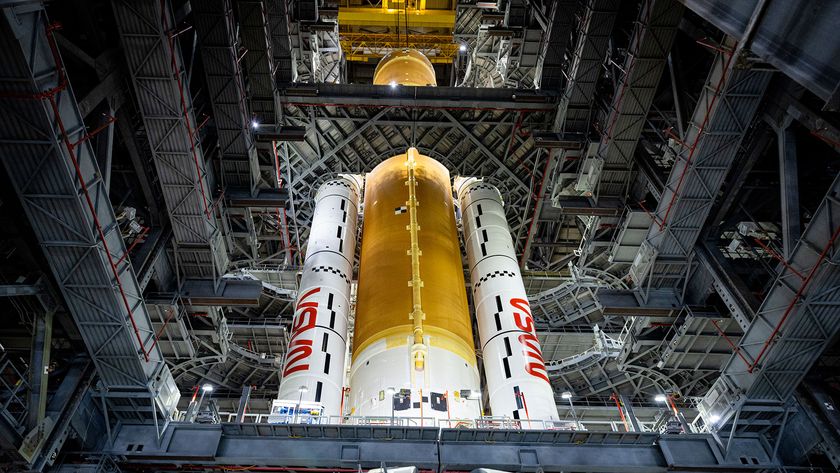
North Korea has always talked the talk, and now it seems to be walking the walk as never before.
The nuclear-armed rogue nation appears to be making progress on an intercontinental ballistic missile (ICBM), which could conceivably allow the Hermit Kingdom to make good on its oft-repeated threat to turn major American cities into "seas of fire," experts say.
"They've probably reached the point where they're going to need to start testing the missiles themselves — the whole system," said Joel Wit, senior fellow at the U.S.-Korea Institute (USKI) at Johns Hopkins University's School of Advanced International Studies. "Most people think that could come sometime this year." [Images: North Korea's Rocket Program]
Last year's successful test-launch of a missile from a submarine suggests that a mobile-strike capability may be within North Korea's grasp soon as well, analysts have said.
North Korean rocket and missile tech: A brief history
The North Korean missile program got its start with the importation of Soviet Scuds, which made their way into the nation in the 1970s. North Korea reworked Scud technology into a number of variants over the years, apparently with the help of Soviet engineers (many of whom fled the USSR after its 1991 collapse).
These versions include the Hwasong-5 and Hwasong-6, which are thought to have a range of a few hundred miles, and the Nodong, which experts believe can reach targets 620 miles to 800 miles (1,000 to 1,300 kilometers) away. (It's hard to know anything for sure about North Korea's missiles and rockets, because the nation's government is extremely secretive and works to keep much information from getting to the outside world.)
North Korea has also developed longer-range missiles, including the Taepodong-1, Musudan and Taepodong-2, which have estimated maximum ranges of about 1,500 miles (2,500 km), 2,000 miles (3,200 km) and 3,000 miles to 5,400 miles (5,000 to 9,000 km), respectively.
Get the Space.com Newsletter
Breaking space news, the latest updates on rocket launches, skywatching events and more!
Taepodong-1 has just one known flight under its belt. In April 1998, a modified space-launch configuration of the vehicle lifted off with a small satellite onboard; Western observers concluded that the launch failed.
The Taepodong-2 failed during a 2006 test flight, its only known liftoff. However, North Korea modified the missile into the Unha space launcher, which lofted satellites to orbit in December 2012 and February 2016.
The Musudan has seen a lot more action. North Korea apparently tested the medium-range missile seven times last year, with just one success, said physicist and missile-technology expert David Wright, co-director of the Union of Concerned Scientists' Global Security Program.
Such flights flout United Nations resolutions, which prohibit North Korea from testing missiles and nuclear weapons. Pyongyang has also conducted five known nuclear tests, with the latest one coming in September 2016. [North Korea Looks Strangely Dark From Space In Asia Fly-Over (Video)]
Working on an ICBM
North Korea could conceivably combine several of these existing vehicles to build an ICBM, topping an Unha first stage with a second stage based on the Musudan and adding a third stage of some sort, Wright said. But there's no evidence that the nation is actually doing that, he added.
"North Korea is probably reluctant to turn the Unha into a ballistic missile, because I think they want something that really is a civil space-launch program that they can point to and say, 'This is what countries do. We're launching satellites; it's not a threat,'" Wright told Space.com. "So my guess is, they won't go that route."
The route that Pyongyang appears to be taking instead, experts say, centers on a missile called the KN-08, a likely Russian-derived vehicle that Western observers first spotted in North Korean military parades about five years ago.
"It is much better suited as a militarily effective ICBM than the Unha is," Brian Weeden, a technical adviser for the nonprofit Secure World Foundation, told Space.com. He noted, for example, that the KN-08 can be launched from a truck, whereas the Unha requires a stationary facility.
Work on the KN-08 has apparently been proceeding apace. For instance, in April 2016, Pyongyang ground-tested a large, liquid-fueled engine that could power the putative ICBM and/or a more muscular variant known as the KN-14.
"Using this technology, North Korea's road-mobile intercontinental ballistic missile (ICBM), the KN-08 or the KN-14 modification, could deliver a nuclear warhead to targets at a distance of 10,000 to 13,000 kilometers [6,200 to 8,000 miles]," aerospace engineer and rocket-propulsion expert John Schilling wrote on 38North.org, a North Korea analysis site, shortly after the test.
"That range, greater than had previously been expected, could allow Pyongyang to reach targets on the U.S. East Coast, including New York or Washington, D.C.," he added.
And North Korea has also been working on a re-entry vehicle, which would protect the warhead during the ICBM's return to Earth's atmosphere from suborbital space. Last year, North Korean leader Kim Jong-un held an event during which he stood next to a re-entry vehicle, said Wit, who is also the co-founder of 38 North (a USKI program).
"I think you can be almost 100 percent certain that they've done [re-entry vehicle] tests on the ground," Wit told Space.com.
During a speech on New Year's Day, Kim announced that Pyongyang was in final preparations to test-launch its ICBM. Wit said such a flight could come soon — possibly as early as next month, when the U.S. and South Korea hold their annual joint military exercises.
"That could trigger a North Korean response," Wit said.
If ICBM testing does indeed start this year, the missiles could potentially be ready for deployment by late 2019, he added.
Pyongyang also conducted a successful test launch from a submarine in August 2016, sending one of its KN-11 (also known as Pukguksong-2) missiles about 300 miles (500 km) toward Japan. Developing this technology to the fullest extent would make North Korea more dangerous and capable, Wright said.
"That's another thing that people are watching — this combination of a missile and a submarine," he said. [North Korea's Rockets and Missiles: 5 Interesting Facts]
The missile that North Korea fired on Sunday (Feb. 12), which traveled 300 miles (500 km) before splashing down in the Sea of Japan, was a land-based version of the KN-11, according to the North Korean news service.
Don't panic
North Korea is famously unpredictable, secretive and prone to outbursts of grandiose and threatening rhetoric; Kim and other officials have repeatedly vowed to wipe out South Korea, Japan and the United States, for example.
But Pyongyang's development of a functional ICBM, if and when that does indeed happen, shouldn't incite panic across the United States, experts said. After all, North Korea has been capable of hitting South Korea and Japan for a while but has yet to do so — probably because the nation knows that such an unprovoked strike would be suicidal, drawing a devastating response from the U.S.
And the Kim regime is not suicidal; rather, it appears focused primarily on strengthening and perpetuating its rule, Weeden said.
"It's very clear that they want to send a signal to the West that they can't be messed with," he said. "There's a rationality there."
There are other reasons to doubt that North Korea will launch a nuclear ICBM attack on the U.S. anytime soon.
For example, Pyongyang is thought to possess just a handful of nuclear weapons. A 2015 SAIS report co-authored by Wit pegged the nation's stockpile at 10 to 16 nukes. By 2020, this number could grow to 20 in a "best-case scenario," and to 100 in a "worst-case scenario," the report predicted.
Each warhead is therefore quite valuable to North Korea, Wright said — meaning the nation probably won't use its nukes lightly.
"It might be the kind of thing you would like to have in your back pocket, to make people think, 'Well, gee, maybe in a bad situation, they might try a Hail Mary pass and see whether it works,'" Wright said. "But it's not the sort of thing that you're going to be able to rely on other than that."
That's not to suggest that North Korea is all bluster, however.
"I think the best bet is that they would use nuclear weapons if they felt the regime was threatened in a serious way," Wit said. "Of course, the main way that might happen is if there's a war on the Korean Peninsula, and U.S. and South Korean troops are moving north."
Follow Mike Wall on Twitter @michaeldwall and Google+. Follow us @Spacedotcom, Facebook or Google+. Originally published on Space.com.
Join our Space Forums to keep talking space on the latest missions, night sky and more! And if you have a news tip, correction or comment, let us know at: community@space.com.

Michael Wall is a Senior Space Writer with Space.com and joined the team in 2010. He primarily covers exoplanets, spaceflight and military space, but has been known to dabble in the space art beat. His book about the search for alien life, "Out There," was published on Nov. 13, 2018. Before becoming a science writer, Michael worked as a herpetologist and wildlife biologist. He has a Ph.D. in evolutionary biology from the University of Sydney, Australia, a bachelor's degree from the University of Arizona, and a graduate certificate in science writing from the University of California, Santa Cruz. To find out what his latest project is, you can follow Michael on Twitter.











